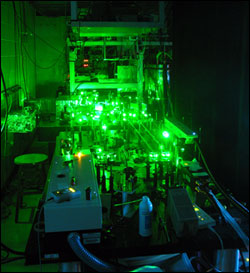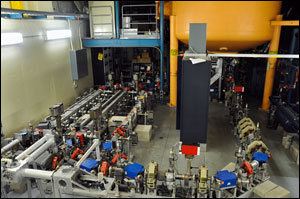
With Laser, Electromagnetic Bottleneck ‘Shattered’
LOS ANGELES, SANTA BARBARA, Calif., and TALLAHASSEE, Fla., Sept. 20, 2012 — Using a high-powered laser to amp up decades-old electron paramagnetic resonance (EPR) spectrometers has yielded a more efficient tool for revealing details about the structure of targeted molecules.
EPR spectroscopy has existed for decades, but it has been limited by the electromagnetic radiation source it uses to excite electrons: At EPR’s more powerful high magnetic fields and frequencies, pulses of power rather than continuous waves excite the targeted electrons.

EPR spectrometer
at the University of California, Santa Barbara. (Image: Susumu Takahashi)
Until recently, EPR spectroscopy was performed with a few tens of gigahertz of electromagnetic radiation. Now, using the University of California, Santa Barbara’s (UCSB) free-electron laser, a multi-university team has used 240 GHz of electromagnetic radiation to power an EPR spectrometer.
The team, which includes researchers from UCSB, USC and Florida State University, used the technology to study the electron spin of free radicals and nitrogen atoms trapped inside a diamond.
“Each electron can be thought of as a tiny magnet that senses the magnetic fields caused by atoms in its nano-neighborhood,” said Mark Sherwin, professor of physics and director of the Institute for Terahertz Science and Technology at UCSB. “With FEL-powered EPR, we have shattered the electromagnetic bottleneck that EPR has faced, enabling electrons to report on faster motions occurring over longer distances than ever before. We look forward to breakthrough science that will lay foundations for discoveries like new drugs and more efficient plastic solar cells.”

UCSB’s free-electron laser, which was used to power the EPR spectrometer. (Image: Susumu Takahashi/USC)
The improvement will pull back the veil that shrouds the molecular world, allowing scientists to study tiny molecules at a high resolution, the investigators said.
The findings, funded by the National Science Foundation and the W.M. Keck Foundation, appeared today in Nature.
For more information, visit: www.usc.edu, www.ucsb.edu or www.fsu.edu
Published: September 2012